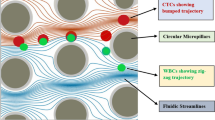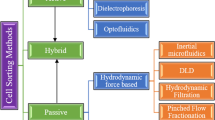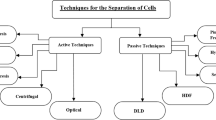Abstract
Recent numerical analyses to optimize the design of microfluidic devices for more effective entrapment or segregation of surrogate circulating tumor cells (CTCs) from healthy cells have been reported in the literature without concurrently accommodating the non-Newtonian nature of the body fluid and the non-uniform geometric shapes of the CTCs. Through a series of two-dimensional proof-of-concept simulations with increased levels of complexity (e.g., number of particles, inline obstacles), we investigated the validity of the assumptions of the Newtonian fluid behavior for pseudoplastic fluids and the circular particle shape for different-shaped particles (DSPs) in the context of microfluidics-facilitated shape-based segregation of particles. Simulations with a single DSP revealed that even in the absence of internal geometric complexities of a microfluidics channel, the aforementioned assumptions led to 0.11–0.21W (W is the channel length) errors in lateral displacements of DSPs, up to 3–20\(\%\) errors in their velocities, and 3–5\(\%\) errors in their travel times. When these assumptions were applied in simulations involving multiple DSPs in inertial microfluidics with inline obstacles, errors in the lateral displacements of DSPs were as high as 0.78W and in their travel times up to 23\(\%\), which led to different (un)symmetric flow and segregation patterns of DSPs. Thus, the fluid type and particle shape should be included in numerical models and experiments to assess the performance of microfluidics for targeted cell (e.g., CTCs) harvesting.






Similar content being viewed by others
References
Aidun CK, Lu Y, Ding E-J (1998) Direct analysis of particulate suspensions with inertia using the discrete Boltzmann equation. J Fluid Mech 373:287–311
Başağaoğlu H, Succi S (2010) Lattice-Boltzmann simulations of repulsive particle-particle and particle-wall interactions: coughing and choking. J Chem Phys 132(5–6):134111
Başağaoğlu H, Meakin P, Succi S, Redden GR, Ginn TR (2008) Two-dimensional lattice-Boltzmann simulation of colloid migration in rough-walled narrow flow channels. Phys Rev E 77:031405
Başağaoğlu H, Allwein S, Succi S, Dixon H, Carrola JT Jr, Stothoff S (2013) Two- and three-dimensional lattice Boltzmann simulations of particle migration in microchannels. Microfluid Nanofluid 15:785–796
Başağaoğlu H, Harwell JR, Nguyen H, Succi S (2017) Enhanced computational performance of the lattice Boltzmann model for simulating micron- and submicron-size particle flows and non-newtonian fluid flows. Comput Phys Commun 213:64–71
Başağaoğlu H, Succi S, Wyrick D, Blount J (2018) Particle shape influences settling and sorting behavior in microfluidic domains. Sci Rep 8:8583
Behdani B, Monjezi S, Carey MJ, Weldon CG, Zhang J, Wang C, Park J (2018) Shape-based separation of micro-/nanoparticles in liquid phases. Biomicrofluidics 12:051503
Benzi R, Succi S, Vergassola M (1992) The lattice-Boltzmann equation: theory and applications. Phys Rep 222:145–197
Bhagat AAS, Hou HW, Li LD, Lim CT, Han J (2011) Pinched flow coupled shear-modulated inertial microfluidics for high-throughput rare blood cell separation. Lab Chip 11:1870–1878
Bhatnagar PL, Gross EP, Krook M (1954) A model for collision process in gases. I. Small amplitude processes in charged and neutral one-component systems. Phys Rev 94(3):511–525
Buick JM, Greated CA (2000) Gravity in a lattice Boltzmann model. Phys Rev E 61:5307–5320
Casavant BP, Mosher R, Warrick JW, Maccoux LJ, Berry SM, Becker JT, Chen V, Lang J, McNeel D, Beebe DJ (2013) A negative selection methodology using a microfluidic platform for the isolation and enumeration of circulating tumor cells. Cancer Discov 4:137–143
D’Avino G (2013) Non-newtonian deterministic lateral displacement separator: theory and simulations. Rheol Acta 52:221–236
Delouei AA, Nazari M, Kayhani MH, Succi S (2014) Non-Newtonian unconfined flow and heat transfer over a heated cylinder using the direct- forcing immersed boundary-thermal lattice Boltzmann method. Phys Rev E 89:053312
Ding E-J, Aidun CK (2003) Extension of the lattice-Boltzmann method for direct simulation of suspended particles near contact. J Stat Phys 112:685–708
Djukic T, Topalovic M, Filipovic N (2015) Numerical simulation of isolation of cancer cells in a microfluidic chip. J Micromech Microeng 25:084012
Dong Y, Skelley AM, Merdek KD, Sprott KM, Jiang C, Pierceall WE, Lin J, Stocum M, Carney WP, Smirnov DA (2013) Microfluidics and circulating tumor cells. J Mol Diagn 15:149–157
Feng J, Hu HH, Joseph DD (1994) Direct simulation of initial value problems for the motion of solid bodies in a Newtonian fluid part 1. Sedimentation. J Fluid Mech 261:95–134
Gabbanelli S, Drazer G, Koplik J (2005) Lattice Boltzmann method for non-Newtonian (power-law) fluids. Phys Rev E 71:046312
Gibbs RJ, Matthews MD, Link DA (1971) The relationship between sphere size and settling velocity. J Sediment Petrol 41:7–18
Gwak H, Kim J, Kashefi-Kheyrabadi L, Kwak B, Hyun K-A, Jung H-I (2018) Progress in circulating tumor cell research using microfluidic devices. Micromachines 9:353
Haber DA, Velculescu VE (2014) Blood-based analyses of cancer: circulating tumor cells and circulating tumor DNA. Cancer Discov 4:650–661
Haddadi H, Di Carlo D (2017) Inertial flow of a dilute suspension over cavities in a microchannel. J Fluid Mech 811:436–467
Hamedi H, Rahimian MH (2011) Numerical simulation of non-Newtonian pseudo-plastic fluid in a micro-channel using the lattice-Boltzmann method. World J Mech 1:231–242
Hao S-J, Wan Y, Xia Y-Q, Zou X, Zheng S-Y (2018) Size-based separation methods of circulating tumor cells. Adv Drug Deliv Rev 125:3–20
Higuera FJ, Succi S (1989) Simulating the flow around a circular cylinder with a lattice Boltzmann equation. Europhys Lett 8:517–521
Huang LR, Cox EC, Austin RH, Sturm JC (2004) Continuous particle separation through deterministic lateral displacement. Science 304:987–990
Hur SC, Chou S-E, Kwon S, Carlo DD (2011) Inertial focusing of non-spherical microparticles. Appl Phys Lett 99:044101
Jarvas G, Szigeti M, Hajba L, Furjes P, Guttman A (2015) Computational fluid dynamics-based design of a microfabricated cell capture device. J Chrom Sci 53:411–416
Khodaee F, Movahed S, Fatouraee N, Daneshmand F (2016) Numerical simulation of separation of circulating tumor cells from blood stream in deterministic lateral displacement (DLD) microfluidic channel. J Mech 1(4):1–9
Kim M, Mo Jung S, Lee K-H, Jun Kang Y, Yang S (2010) A microfluidic device for continuous white blood cell separation and lysis from whole blood. Artif Organs 34:996–1002
Ladd AJC (1994) Numerical simulations of particulate suspensions via a discretized Boltzmann equation. Part 1. Theoretical foundation. J Fluid Mech 271:285–309
Lanotte L, Mauer J, Mendez S, Fedosov DA, Fromental J-M, Claveria V, Nicoud F, Gompper G, Abkarian M (2016) Red cells’ dynamic morphologies govern blood shear thinning under microcirculatory flow conditions. PNAS 113:13289–13294
Li M, Muñoz HE, Goda K, Carlo DD (2017) Shape-based separation of microalga Euglena gracilis using inertial microfluidics. Sci Rep 7:10802
Marrinucci D, Bethel K, Lazar D, Fisher J, Huynh E, Clark P, Bruce R, Nieva J, Kuhn P (2014) Cytomorphology of circulating colorectal tumor cells:a small case series. J Oncol 2010:861341
Masaeli M, Sollier E, Amini H, Mao W, Camacho K, Doshi N, Mitragotri S, Alexeev A, Di Carlo D (2012) Continuous inertial focusing and separation of particles by shape. Phys Rev E 2:031017
Nguyen N-Q, Ladd AJC (2002) Lubrication corrections for lattice-Boltzmann simulations of particle suspensions. Phys Rev E 66:046708
Nivedita N, Papautsky I (2013) Continuous separation of blood cells in spiral microfluidic devices. Biomicrofluidics 7:05410
O’Rourke J (1998) Point in polygon. In: Computational geometry in C, 2nd edn. Cambridge University Press, New York
Paié P, Che J, Di Carlo D (2017) Effect of reservoir geometry on vortex trapping of cancer cells. Microfluid Nanofluid 21:104
Park S, Ang R, Duffy S, Bazov J, Black PC, Ma H, Eddin DT (2014) Morphological differences between circulating tumor cells from prostate cancer patients and cultured prostate cancer cells. PLoS One 9:e85264
Prestininzi P, Montessori A, La Rocca M, Succi S (2016) Reassessing the single relaxation time lattice Boltzmann method for the simulation of Darcy’s flows. Int J Mod Phys C 27:1650037
Psihogios J, Kainourgiakis ME, Yiotis AG, Papaioannous ATh, Stubos AK (2007) Lattice Boltzmann of non-Newtonian flow in digitally reconstructed porous domain. Transp Porous Med 70:279–292
Qian YH, D’Humieres D, Lallemand P (1992) Lattice BGK models for Navier–Stokes equation. Europhys Lett 17:479–484
Ségre G, Silberberg A (1961) Radial particle displacements in Poiseuille flow of suspensions. Nature (London) 189:209–210
Ségre G, Silberberg A (1962) Behavior of macroscopic rigid spheres in Poiseuille flow. Fluid Mech 14:136–157
Shamloo A, Ahmad S, Momeni M (2018) Design and parameter study of integrated microfluidic platform for ctc isolation and enquiry; a numerical approach. Biosensors 8:56
Succi S (2001) The lattice-Boltzmann equation for fluid dynamics and beyond. Oxford University Press, New York
Whitaker S (1968) Introduction to fluid mechanics. Krieger Pub Com, Florida
Wolf-Gladrow DA (2000) A lattice gas cellular automata and lattice Boltzmann model. Springer, Berlin
Yilmaz F, Gundogdu MY (2008) A critical review on blood flow in large arteries; relevance to blood rheology, viscosity models, and physiologic conditions. Korea Aust Rheol J 20:197–211
Zeming KK, Ranjan S, Zhang Y (2013) Rotational separation of non-spherical bioparticles using I-shaped pillar arrays in a microfluidic device. Nat Commun 4:1625
Zhenhua X, Connington KW, Rapaka S, Yue P, Feng JJ, Chen S (2009) Flow patterns in the sedimentation of an elliptical particle. J Fluid Mech 625:249–272
Acknowledgements
Funding for this research was provided by Southwest Research Institute’s Internal Research and Development Program, 18R-8602 and 15R-8651. SS kindly acknowledges funding from the European Research Council under the European Union’s Horizon 2020 Framework Programme (No. FP/2014- 2020)/ERC Grant Agreement No. 739964 (COPMAT).
Author information
Authors and Affiliations
Corresponding author
Additional information
Publisher's Note
Springer Nature remains neutral with regard to jurisdictional claims in published maps and institutional affiliations.
This article is part of the topical collection “Particle motion in non-Newtonian microfluidics” guest edited by Xiangchun Xuan and Gaetano D’Avino.
Rights and permissions
About this article
Cite this article
Başağaoğlu, H., Blount, J., Succi, S. et al. Combined effects of fluid type and particle shape on particles flow in microfluidic platforms. Microfluid Nanofluid 23, 84 (2019). https://doi.org/10.1007/s10404-019-2251-9
Received:
Accepted:
Published:
DOI: https://doi.org/10.1007/s10404-019-2251-9




